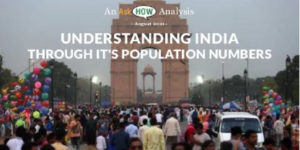Inequality: China through an Indian lensfeatured
China is the only country that you can compare with India, given the size, complexity and stage of development of the two countries. Over a series of articles, I will compare the two countries on different dimensions. In this piece, I will talk about reasons for inequality arising from urbanization and rapid development [1].

Both China and India have developed rapidly over the last few decades: The former faster than the latter. As a country develops, some inequality is natural. An undeveloped country is largely rural and agriculture is the main occupation of people. The income from agriculture is generally not very high. Citizens who are lucky enough to get opportunity in either manufacturing or in modern services, typically in urban areas, see their incomes rise much faster. Farmers in both China and India have faced an additional challenge. Both countries place a heavy emphasis on agricultural self sufficiency, especially in grains. This is a sensible policy for the two gigantic countries. If either of the countries falls short of basic food grain production, they would have to depend on imports. The demand from either of these two giants would lead to a spike in world prices. The sensible policy, however, can slow down the growth of agricultural incomes. In China, this policy is implemented as quotas for grain production. A farmer in China is obliged to produce certain amount of grain even if he has other more lucrative options. In India, a combination of export restrictions and Minimum Support Prices (MSP) create hurdles for farmers to shift away from food grain production.
Migration to places with best opportunities for employment can decrease income inequality but citizens in both countries face challenges. The extent of migration from rural areas to urban areas in China has been astonishing. However, this migration has come under restrictive rules. China has a hukou or residence registration system. Under this system, migrants were not allowed to bring their families when they migrated to cities. If and when they were allowed to bring families, migrants could not admit their children to schools or get medical services or buy formal housing. Even the children of migrants faced discrimination. The hukou system has become progressively weaker but can still impose costs on migrants. For example, migrants still face restrictions when going to cities with a population of more than 5 million where they may have the best opportunities. Many people believe that these restrictions are in place because the elite in the larger cities do not wish to see unfettered migration leading to slums such as those in Mumbai and Manila. The net result of all these restrictions is that even today the wages of rural migrants are 60% of urban residents.
Compared to China, India has very little legal restrictions on migration. In practice, however, migrants have found it difficult to get good housing or medical and health facilities for their families. Migrants may also not get the right to other government services such as food grain in ration shops although there are initiatives to fix such problems.
Unfavorable laws and practices in agriculture and migration have worsened inequalities in China. These practices have an echo in India. However, one of the most significant causes of inequality in China — property rights — is unique to that country.
Until 1990s, most urban Chinese lived in apartments assigned to them by their work units. These state units were told to sell the apartments to the tenants. When the buyers sold their apartments after a lock-in period, they got a much higher price. This was a huge transfer of wealth to urban residents. In 2003, when this transfer was completed, it was estimated that the value of wealth transfer was USD 540 billion or 1/3rd of the GDP in that year. Rural Chinese got no such transfer and what is more their property rights are much weaker.
Under Chairman Mao, all farm land was given over to farming collectives. There was no incentive for farmers to invest in the land that they were farming. Unsurprisingly, the food production fell drastically. The farms were first decollectivized in 1979–83. Farmers got the right to farm a specified plot for 1–3 year. In mid 1980s this was extended to 15 years and in 1993 the term was increased to 30 years. However, a Chinese farmer does not have the right to sell or mortgage his farm. It gets worse. City governments can take over farm land at deeply discounted prices and then sell them to urban property developers at a much higher price. This is a significant source of income for the local governments. The World Bank estimated that in 1990–2010, that city governments took over land and compensated farmers at around USD 300 Billion less than the market value.
In India too, there are hurdles which make it tough for rural property owners to realize the value of their land when they sell it. For example, conversion of Agricultural land to Non-Agricultural land can get stuck in a bureaucratic maze. Additionally, politically connected individuals can prey on the lack of knowledge of farmers and buy their land and then sell it at a premium. These hurdles, however deplorable, are nothing compared to the lack of legal rights of rural Chinese.
In spite of these challenges, China has urbanized at an astonishing rate. In 1978, only 18% of the country lived in urban areas and this had increased to 60% by 2018. As per the 2011 Census, 31.2 % of India lived in urban areas (although this low urban share may be because of our very strict definitions as I have explained here. Under alternate definitions, more than 50% -even two thirds – of India may be urban).
Due to industrialization and urbanization, incomes in China have shot up. In 1979, the national income per person was just 200 Dollars per year. In 2018 it was around nearly ten thousand dollars (India’s income in 2018 was less than 2000). In 1979, 810 million people lived in ‘extreme poverty’ in China as per the World Bank definition. Today the number is less than 10 million. The life expectancy in that country has increased from under 50 to 75 (India’s life expectancy in 2018 was under 70).* Interestingly, China has not only done better than India in Income and quality of life metrics, but also inequality in that country, as defined by the Gini index, is lower.
What China did very well was to create a demand for workers in the manufacturing sector. This demand more than compensated for the severe structural constraints that I have described. The inequality increased but, in my opinion, it was more than compensated for by increase in incomes and other quality of life indicators for most people. Something for the policy makers in India to think about.
I am trying to understand China better and this is my first article on India and China comparisons. I will keep posting what I learn in this list — Viewing China through an Indian lens.
[1] Information on China is from the excellent book “China’s Economy” by Arthur P. Krober, unless otherwise stated.
*The numbers for China and India are from different sources. Rather than getting hung up on precise numbers, note the scale difference.
If you wish to stay in touch with my writing, follow me on medium. Click on the envelope icon to get your stories delivered in your Inbox.
You can follow AskHow India (@AskHowIndia) or me (@YogeshUpadh) on twitter or on LinkedIn
Thanks to Anurag and Rajnish for pointing out typos.
Author –
Yogesh Upadhyaya
(Yogesh Upadhyaya is one of the founders of AskHow India. Blogs are personal views.)



